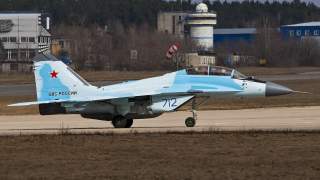Could This New Russian Fighter Kill an F-22 or F-35 in Combat?
The MiG-35 is here.
While “4++” means little in an absolute sense, it’s not difficult to see why Mikoyan insists on characterizing the MiG-35 this way. They want to present it as, not just an iteration, but a massive technical leap over the MiG-29 that it succeeds. It seems reasonable enough to draw a hard distinction between fighters separated by over forty years. However, that narrative of an exponential improvement is somewhat complicated by the multitude of MiG-29 variants released over the prior decades. For instance, many of the MiG-35’s chassis durability and landing gear upgrades can be traced directly to the recent, carrier-based MiG-29K.
With Russia’s MiG-29 nearing the end of its shelf life as Russia’s staple multirole fighter, the Russian Aerospace Forces (VKS) are taking an increasing interest in its successor: the MiG-35.
For years, its manufacturer has marketed the MiG-35 as a “4++” fighter: “I would say that this is a new plane that surpasses our foreign competitors. In other words, this is a 4++ level plane,” stated Mikoyan General Director Ilya Tarasenko in a recent interview.
(This first appeared in May 2019.)
Russian President Vladimir Putin echoed this sentiment at a Kremlin conference: “I note that the new multipurpose MiG-35 fighter has enhanced flight and technical characteristics and is equipped with the very latest weapons systems. You know this better than I. It can follow from 10 to 30 targets at once, and can operate over land or sea. This is a genuinely unique and promising aircraft, 4++, you could say, very close to being fifth generation.”
But what exactly does “4++” mean, and is the MiG-35 really a hair’s breadth away from being considered a fifth-generation fighter?
A recent documentary from T24, a Russian state-funded television channel, sheds light on the MiG-35’s capabilities while offering plenty of high-fidelity footage of the plane in action.
The documentary involves a series of interviews with Mikoyan executives, aerospace engineers, VKS officers, and test pilots. T24’s crew managed to secure a tour inside the 929th Chkalov State Flight-Test Center in Akhtubinsk, where they marvel at the painstaking attention to detail and degree of human labor required to manufacture a military-grade aircraft.
Much of the video is a rehash of older known information, including the MiG-35’s proprietary Zhuk-AE radar and ability to land under extreme circumstances. However, it offers a rare glimpse into what the test pilots themselves-- as opposed to defense analysts or industry executives-- have to say about the plane. They seem particularly excited about its enhanced offensive capabilities, remarking that MiG-35’s nine hardpoints allow for armament configurations that dwarf the Mig-29 in sheer firepower. The MiG-35 is compatible with the full range of KAB-500 Laser, TV, and GLONASS guided bombs, which should enable it to handle some of the high-intensity combat operations that would have been too tall an order for its predecessor. The KAB-500 might clear up the prior confusion over UAC chief Yuriy Slysar’s assertion that the MiG-35 would boast “laser weapons”; he was likely referring to the KAB-500 Laser, not actual laser beam projectiles.
These upgrades will inevitably come at the expense of maneuverability, which is unsurprising given the manufacturer’s design direction over the past decades. With every variant, Mikoyan has worked to rebrand the MiG-29 from an air-superiority fighter to an all-purpose that excels in a ground attack capacity.
While “4++” means little in an absolute sense, it’s not difficult to see why Mikoyan insists on characterizing the MiG-35 this way. They want to present it as, not just an iteration, but a massive technical leap over the MiG-29 that it succeeds. It seems reasonable enough to draw a hard distinction between fighters separated by over forty years. However, that narrative of an exponential improvement is somewhat complicated by the multitude of MiG-29 variants released over the prior decades. For instance, many of the MiG-35’s chassis durability and landing gear upgrades can be traced directly to the recent, carrier-based MiG-29K.
Given the considerable improvements that it inherits from prior variants, it is difficult to see how the MiG-35 revolutionizes Russia’s aircraft roster. It is, however, shaping up to the culmination of decades’ worth of Russian aerospace engineering experience, and Russia’s most capable multi-role fighter to date.
Mark Episkopos is a frequent contributor to The National Interest and serves as research assistant at the Center for the National Interest. Mark is also a PhD student in History at American University.

